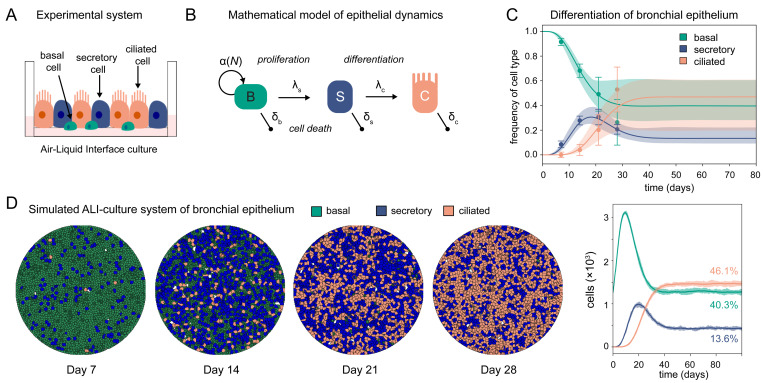
PLoS Comput Biol, Aug 2023
Benjamin Raach, Nils Bundgaard, Marika J. Haase, Joern Starruss, Rocio Sotillo, Megan L. Stanifer, Frederik Graw
Influence of cell type specific infectivity and tissue composition on SARS-CoV-2 infection dynamics within human airway epithelium
Human airway epithelium (HAE) represents the primary site of viral infection for SARS-CoV-2. Comprising different cell populations, a lot of research has been aimed at deciphering the major cell types and infection dynamics that determine disease progression and severity. However, the cell type-specific replication kinetics, as well as the contribution of cellular composition of the respiratory epithelium to infection and pathology are still not fully understood. Although experimental advances, including Air-liquid interface (ALI) cultures of reconstituted pseudostratified HAE, as well as lung organoid systems, allow the observation of infection dynamics under physiological conditions in unprecedented level of detail, disentangling and quantifying the contribution of individual processes and cells to these dynamics remains challenging. Here, we present how a combination of experimental data and mathematical modelling can be used to infer and address the influence of cell type specific infectivity and tissue composition on SARS-CoV-2 infection dynamics. Using a stepwise approach that integrates various experimental data on HAE culture systems with regard to tissue differentiation and infection dynamics, we develop an individual cell-based model that enables investigation of infection and regeneration dynamics within pseudostratified HAE. In addition, we present a novel method to quantify tissue integrity based on image data related to the standard measures of transepithelial electrical resistance measurements. Our analysis provides a first aim of quantitatively assessing cell type specific infection kinetics and shows how tissue composition and changes in regeneration capacity, as e.g. in smokers, can influence disease progression and pathology. Furthermore, we identified key measurements that still need to be assessed in order to improve inference of cell type specific infection kinetics and disease progression. Our approach provides a method that, in combination with additional experimental data, can be used to disentangle the complex dynamics of viral infection and immunity within human airway epithelial culture systems.
Visit Journal